Core methods#
Time series methods#
restrict#
restrict is used to get time points within an IntervalSet. This method is available for TsGroup, Tsd, TsdFrame, TsdTensor and Ts objects.
tsdframe.restrict(epochs)
Time (s) a b c
---------- ---------- ---------- ----------
10.0 -0.160098 -1.3213 -1.63263
11.0 0.664506 -0.84896 -0.636439
12.0 -1.02016 0.52996 0.0410944
13.0 1.08093 0.0544279 1.92479
14.0 0.0234569 -1.36605 2.17899
15.0 -0.269803 0.625969 -0.84742
16.0 0.942652 -0.118563 1.5204
...
74.0 -0.586674 0.368829 0.313969
75.0 -0.0123163 1.64867 0.553346
76.0 0.287332 0.616024 -1.3523
77.0 0.704453 -0.849912 0.496143
78.0 0.440487 1.20576 2.02331
79.0 -0.0650633 -1.03845 0.316509
80.0 1.57209 0.633285 -0.551887
dtype: float64, shape: (32, 3)
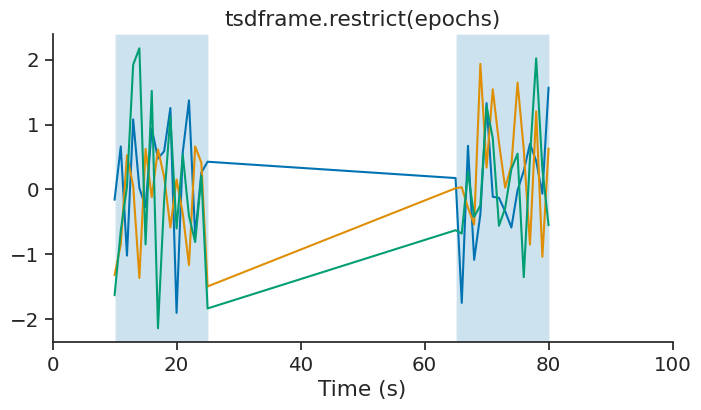
This operation update the time support attribute accordingly.
print(epochs)
print(tsdframe.restrict(epochs).time_support)
index start end
0 10 25
1 65 80
shape: (2, 2), time unit: sec.
index start end
0 10 25
1 65 80
shape: (2, 2), time unit: sec.
in_interval#
in_interval is similar to restrict, except instead of returning the restricted time series, it returns a Tsd of booleans for each time point indicating whether or not it falls within the intervals of an IntervalSet.
tsdframe.in_interval(epochs)
Time (s)
---------- --
0.0 0
1.0 0
2.0 0
3.0 0
4.0 0
5.0 0
6.0 0
...
93.0 0
94.0 0
95.0 0
96.0 0
97.0 0
98.0 0
99.0 0
dtype: bool, shape: (100,)
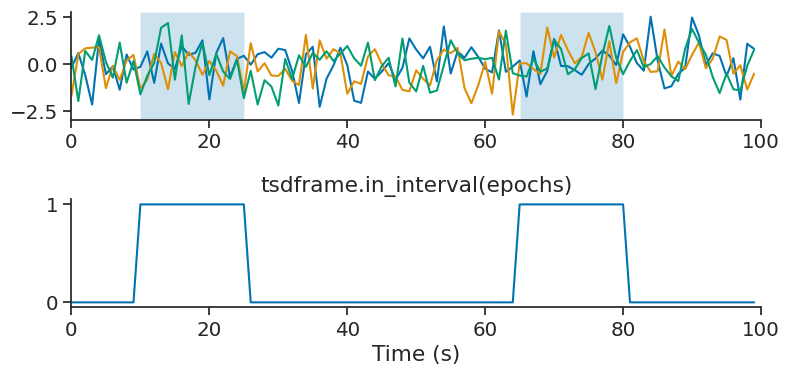
count#
count returns the number of timestamps within bins or epochs of an IntervalSet object.
This method is available for TsGroup, Tsd, TsdFrame, TsdTensor and Ts objects.
With a defined bin size:
count = tsgroup.count(bin_size=1.0, time_units='s')
print(count)
Time (s) 0 1 2
---------- --- --- ---
0.5 0 0 0
1.5 0 0 0
2.5 0 1 0
3.5 0 0 0
4.5 0 1 0
5.5 0 0 1
6.5 0 1 0
...
93.5 0 0 0
94.5 0 0 0
95.5 0 1 0
96.5 0 0 0
97.5 0 0 1
98.5 0 0 1
99.5 0 0 0
dtype: int64, shape: (100, 3)
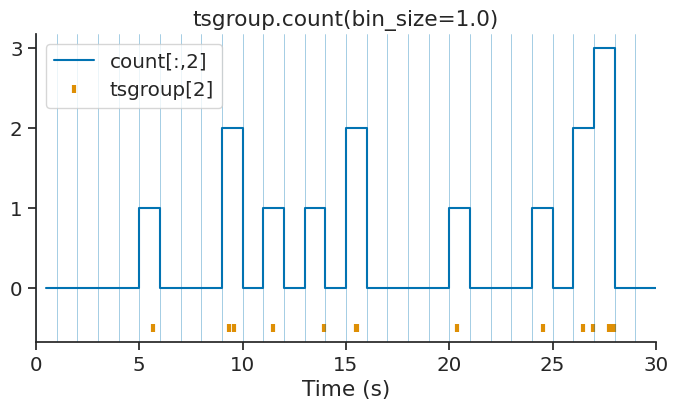
With an IntervalSet:
count_ep = tsgroup.count(ep=epochs)
print(count_ep)
Time (s) 0 1 2
---------- --- --- ---
17.5 2 1 6
72.5 2 3 3
dtype: int64, shape: (2, 3)
trial_count#
TsGroup and Ts objects each have the method trial_count, which builds a trial-based count tensor from an IntervalSet object.
Similar to count, this function requires a bin_size parameter which determines the number of time bins within each trial.
The resulting tensor has shape (number of group elements, number of trials, number of time bins) for TsGroup objects,
or (number of trials, number of time bins) for Ts objects.
ep = nap.IntervalSet([5, 17, 30, 50], metadata={'trials':[1, 2]})
tensor = tsgroup.trial_count(ep, bin_size=2)
print(tensor, "\n")
print("Tensor shape = ", tensor.shape)
[[[ 0. 1. 0. 0. 0. 1. nan nan nan nan]
[ 0. 0. 0. 0. 0. 0. 0. 1. 1. 0.]]
[[ 1. 2. 0. 0. 0. 0. nan nan nan nan]
[ 0. 1. 1. 0. 0. 1. 1. 0. 0. 0.]]
[[ 1. 0. 2. 1. 1. 2. nan nan nan nan]
[ 1. 1. 0. 0. 0. 2. 0. 0. 1. 0.]]]
Tensor shape = (3, 2, 10)
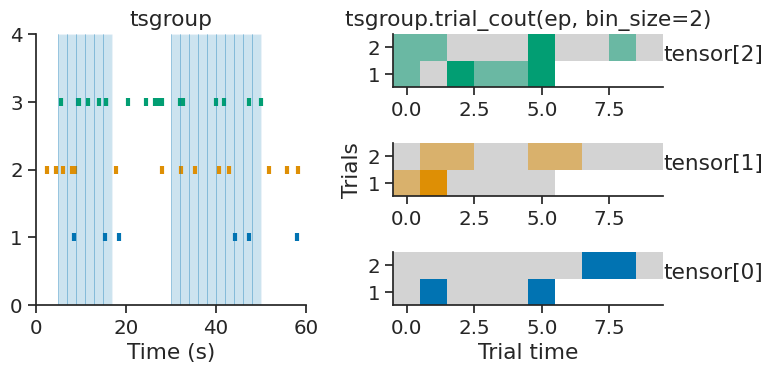
The array is padded with NaNs when the trials have uneven durations,
The padding value can be controlled using the parameter padding_value.
Additionally, the parameter align can change whether the count is aligned to the “start” or “end” of each trial.
tensor = tsgroup.trial_count(ep, bin_size=2, align="end", padding_value=-1)
print(tensor, "\n")
print("Tensor shape = ", tensor.shape)
[[[-1. -1. -1. -1. 0. 1. 0. 0. 0. 1.]
[ 0. 0. 0. 0. 0. 0. 0. 1. 1. 0.]]
[[-1. -1. -1. -1. 1. 2. 0. 0. 0. 0.]
[ 0. 1. 1. 0. 0. 1. 1. 0. 0. 0.]]
[[-1. -1. -1. -1. 1. 0. 2. 1. 1. 2.]
[ 1. 1. 0. 0. 0. 2. 0. 0. 1. 0.]]]
Tensor shape = (3, 2, 10)
bin_average#
bin_average downsamples time series by averaging data point falling within a bin. This method is available for Tsd, TsdFrame and TsdTensor. While bin_average is good for downsampling with precise control of the resulting bins, it does not apply any antialiasing filter. The function decimate is also available for down-sampling without aliasing.
tsdframe.bin_average(3.5)
Time (s) a b c
---------- ---------- ---------- ---------
1.75 -0.600178 0.123256 -0.171383
5.25 0.205043 -0.173812 0.297069
8.75 -0.338422 -0.382867 -0.339989
12.25 0.241759 -0.0881908 0.443148
15.75 0.2933 -0.0599892 0.177744
19.25 -0.0186235 -0.0801504 0.123854
22.75 0.373754 -0.115698 -0.118342
...
75.25 -0.103886 0.877842 -0.161662
78.75 0.662992 -0.01233 0.571018
82.25 0.19222 0.88796 0.236822
85.75 0.0498957 0.0849067 -0.115946
89.25 0.575153 0.104025 0.582924
92.75 0.609422 0.660595 -0.163165
96.25 -0.755702 0.224588 -1.1018
dtype: float64, shape: (28, 3)
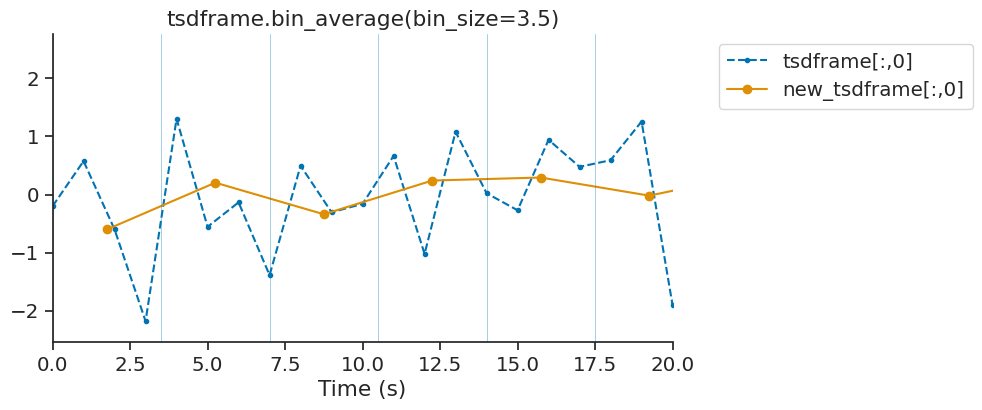
decimate#
The decimate method downsamples the time series by an integer factor after an antialiasing filter.
new_tsd = tsd.decimate(down=4)
The original time series was sampled at 1Hz. The new time series has a rate of 0.25 Hz.
print(f"Original rate : {tsd.rate}")
print(f"New rate : {new_tsd.rate}")
Original rate : 1.0
New rate : 0.25
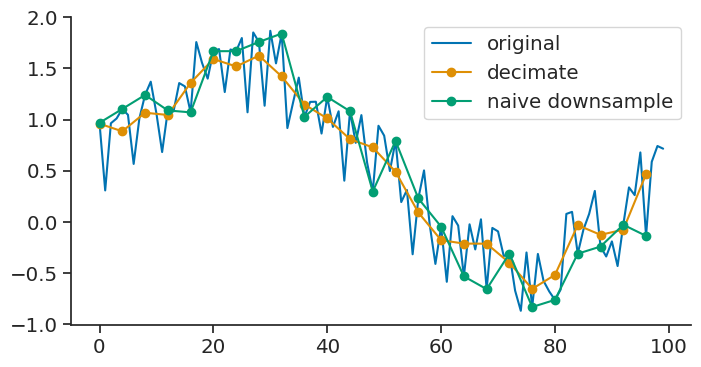
interpolate#
The interpolate method of Tsd, TsdFrame and TsdTensor can be used to fill gaps in a time series. It is a wrapper of numpy.interp.
new_tsd = tsd.interpolate(ts)
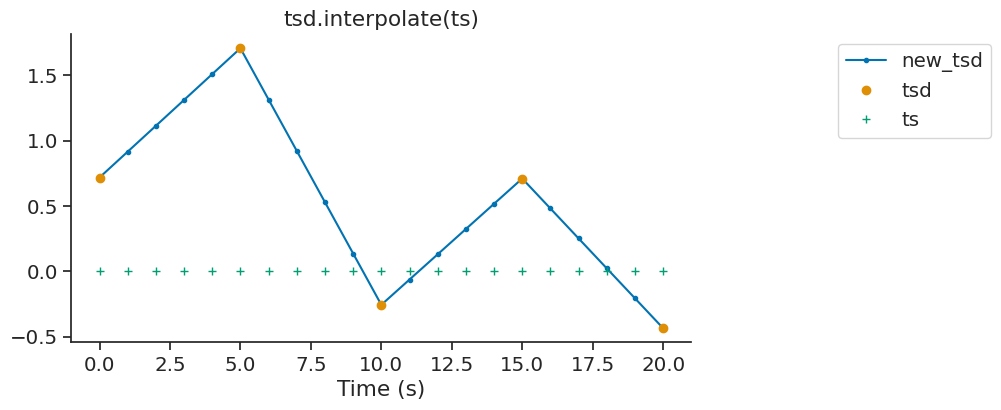
value_from#
By default, value_from assigns to timestamps the closest value in time from another time series. Let’s define the time series we want to assign values from.
For every timestamps in tsgroup, we want to assign the closest value in time from tsd.
tsgroup_from_tsd = tsgroup.value_from(tsd)
We can display the first element of tsgroup and tsgroup_sin.
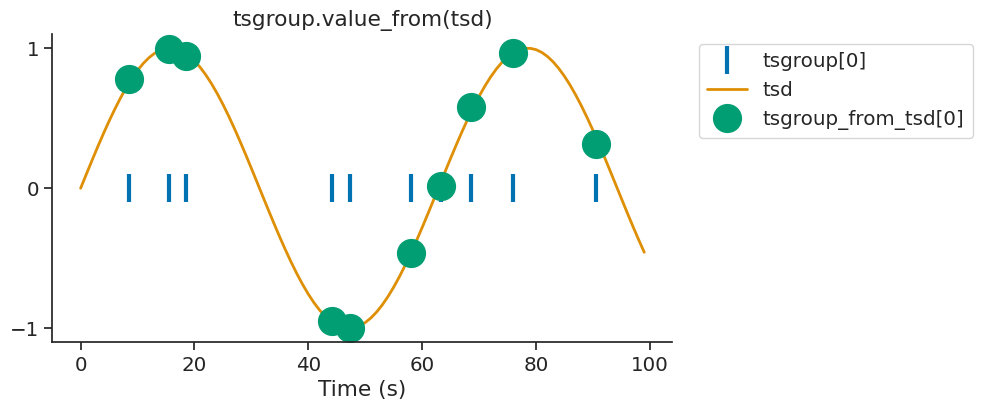
The argument mode can control if the nearest target time is taken before or
after the reference time.
In this case, the variable ts receive data from the time point before.
new_ts_before = ts.value_from(tsd, mode="before")

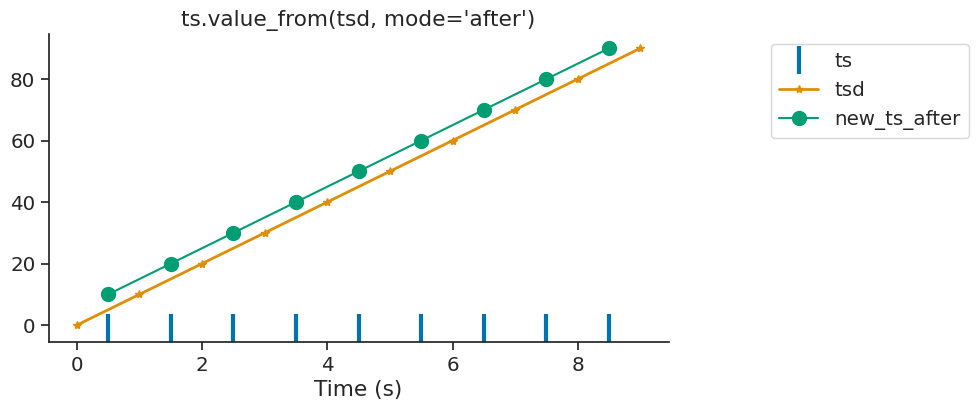
If there is no time point found before or after or within the interval, the function assigns Nans.
tsd = nap.Tsd(t=np.arange(1, 10, 1), d=np.arange(10, 100, 10))
ep = nap.IntervalSet(start=0, end = 10)
ts = nap.Ts(t=[0, 9])
# First ts is at 0s. First tsd is at 1s.
ts.value_from(tsd, ep=ep, mode="before")
Time (s)
---------- ---
0 nan
9 90
dtype: float64, shape: (2,)
threshold#
The method threshold of Tsd returns a new Tsd with all the data above or below a certain threshold. Default is above. The time support of the new Tsd object get updated accordingly.
tsd_above = tsd.threshold(0.5, method='above')
This method can be used to isolate epochs for which a signal is above/below a certain threshold.
epoch_above = tsd_above.time_support
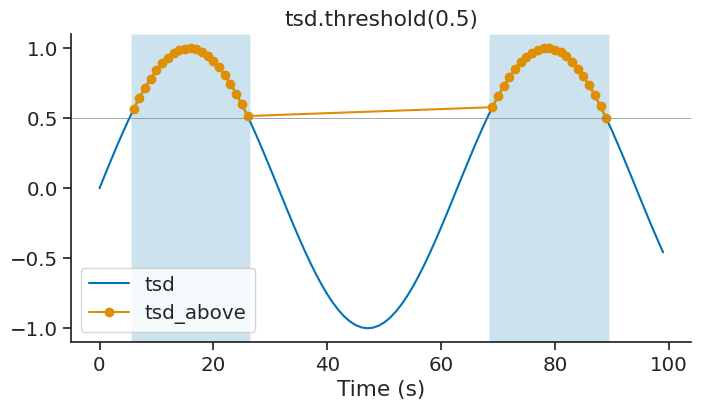
derivative#
The derivative method of Tsd, TsdFrame and TsdTensor can be used to calculate the derivative of a time series with respect to time. It is a wrapper of numpy.gradient.
derivative = tsd.derivative(ep=ep)
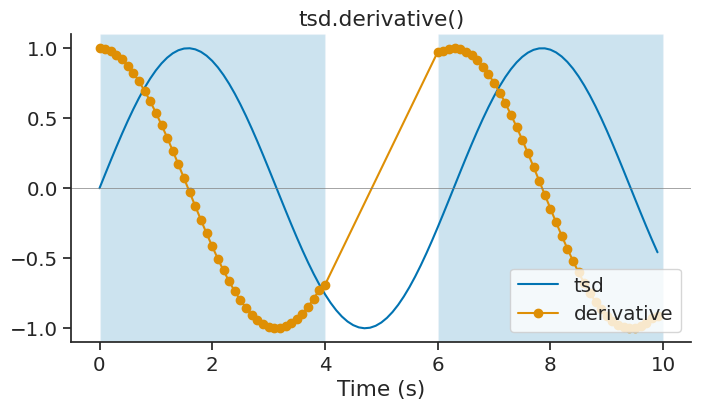
to_trial_tensor#
Tsd, TsdFrame, and TsdTensor all have the method to_trial_tensor, which creates a numpy array from an IntervalSet by slicing the time series. The resulting tensor has shape (shape of time series, number of trials, number of time points), where the first dimension(s) is dependent on the object.
tsd = nap.Tsd(t=np.arange(0, 100, 1), d=np.sin(np.arange(0, 10, 0.1)))
ep = nap.IntervalSet([0, 10, 30, 50, 70, 75], metadata={'trials':[1, 2, 3]})
print(ep)
index start end trials
0 0 10 1
1 30 50 2
2 70 75 3
shape: (3, 2), time unit: sec.
The following example returns a tensor with shape (3, 21), for 3 trials and 21 time points, where the first dimension is dropped due to this being a Tsd object.
tensor = tsd.to_trial_tensor(ep)
print(tensor, "\n")
print("Tensor shape = ", tensor.shape)
[[ 0. 0.09983342 0.19866933 0.29552021 0.38941834 0.47942554
0.56464247 0.64421769 0.71735609 0.78332691 0.84147098 nan
nan nan nan nan nan nan
nan nan nan]
[ 0.14112001 0.04158066 -0.05837414 -0.15774569 -0.2555411 -0.35078323
-0.44252044 -0.52983614 -0.61185789 -0.68776616 -0.7568025 -0.81827711
-0.87157577 -0.91616594 -0.95160207 -0.97753012 -0.993691 -0.99992326
-0.99616461 -0.98245261 -0.95892427]
[ 0.6569866 0.72896904 0.79366786 0.85043662 0.8987081 0.93799998
nan nan nan nan nan nan
nan nan nan nan nan nan
nan nan nan]]
Tensor shape = (3, 21)

Since trial 2 is twice as long as trial 1, the array is padded with NaNs. The padding value can be changed by setting the parameter padding_value.
tensor = tsd.to_trial_tensor(ep, padding_value=-1)
print(tensor, "\n")
print("Tensor shape = ", tensor.shape)
[[ 0. 0.09983342 0.19866933 0.29552021 0.38941834 0.47942554
0.56464247 0.64421769 0.71735609 0.78332691 0.84147098 -1.
-1. -1. -1. -1. -1. -1.
-1. -1. -1. ]
[ 0.14112001 0.04158066 -0.05837414 -0.15774569 -0.2555411 -0.35078323
-0.44252044 -0.52983614 -0.61185789 -0.68776616 -0.7568025 -0.81827711
-0.87157577 -0.91616594 -0.95160207 -0.97753012 -0.993691 -0.99992326
-0.99616461 -0.98245261 -0.95892427]
[ 0.6569866 0.72896904 0.79366786 0.85043662 0.8987081 0.93799998
-1. -1. -1. -1. -1. -1.
-1. -1. -1. -1. -1. -1.
-1. -1. -1. ]]
Tensor shape = (3, 21)
By default, time series are aligned to the start of each trial. To align the time series to the end of each trial, the optional parameter align can be set to “end”.
tensor = tsd.to_trial_tensor(ep, align="end")
print(tensor, "\n")
print("Tensor shape = ", tensor.shape)
[[ nan nan nan nan nan nan
nan nan nan nan 0. 0.09983342
0.19866933 0.29552021 0.38941834 0.47942554 0.56464247 0.64421769
0.71735609 0.78332691 0.84147098]
[ 0.14112001 0.04158066 -0.05837414 -0.15774569 -0.2555411 -0.35078323
-0.44252044 -0.52983614 -0.61185789 -0.68776616 -0.7568025 -0.81827711
-0.87157577 -0.91616594 -0.95160207 -0.97753012 -0.993691 -0.99992326
-0.99616461 -0.98245261 -0.95892427]
[ nan nan nan nan nan nan
nan nan nan nan nan nan
nan nan nan 0.6569866 0.72896904 0.79366786
0.85043662 0.8987081 0.93799998]]
Tensor shape = (3, 21)
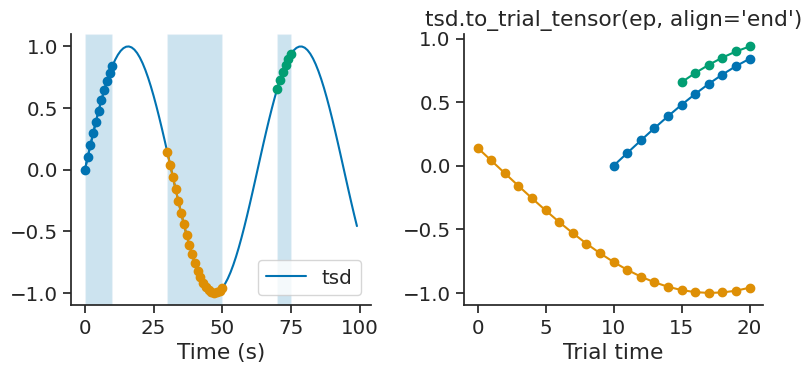
time_diff#
Ts, Tsd, TsdFrame, TsdTensor, and TsGroup all have the method time_diff, which computes the time differences between subsequent timepoints.
For example, if a Ts object contained a set of spike times, time_diff would compute the inter-spike interval (ISI).
This method returns a new Tsd object, with values being each time difference, and time indices being their reference time point.
Passing epochs restricts the computation to the given epochs.
The reference time point can be adjusted by the optional align parameter, which can be set to "start", "center", or "end" (the default being "center").
time_diffs = ts.time_diff(align="center")
print(time_diffs)
Time (s)
---------- --
3 4
5.5 1
9 6
14 4
17 2
18.5 1
dtype: float64, shape: (6,)
Setting align="center" sets the reference time point to the midpoint between the timestamps used to calculate the time difference.
Setting align="start" or align="end" sets the reference time point to the earlier or later timestamp, respectively.
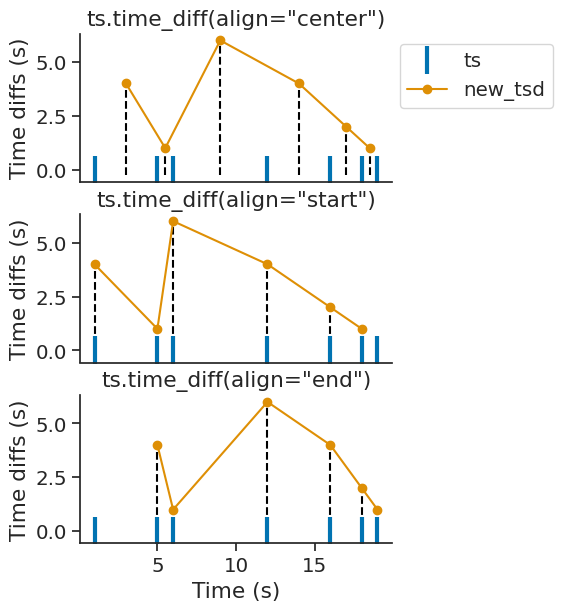
Mapping between TsGroup and Tsd#
It’s is possible to transform a TsGroup to Tsd with the method
to_tsd and a Tsd to TsGroup with the method to_tsgroup.
This is useful to flatten the activity of a population in a single array.
tsd = tsgroup.to_tsd()
print(tsd)
Time (s)
------------ --
2.373298803 1
4.522163744 1
5.668638876 2
6.042859693 1
8.030738997 1
8.523766412 0
8.640571735 1
...
84.167895002 2
90.579992015 0
91.849344096 1
92.011366071 2
95.788289067 1
97.370866616 2
98.367758759 2
dtype: float64, shape: (60,)
The object tsd contains all the timestamps of the tsgroup with
the associated value being the index of the unit in the TsGroup.
The method to_tsgroup converts the Tsd object back to the original TsGroup.
back_to_tsgroup = tsd.to_tsgroup()
print(back_to_tsgroup)
Index rate
------- ------
0 0.1
1 0.2
2 0.3
Parameterizing a raster#
The method to_tsd makes it easier to display a raster plot.
TsGroup object can be plotted with plt.plot(tsgroup.to_tsd(), 'o').
Timestamps can be mapped to any values passed directly to the method
or by giving the name of a specific metadata name of the TsGroup.
tsgroup['label'] = np.arange(3)*np.pi
print(tsgroup)
Index rate label
------- ------ -------
0 0.1 0
1 0.2 3.14
2 0.3 6.28
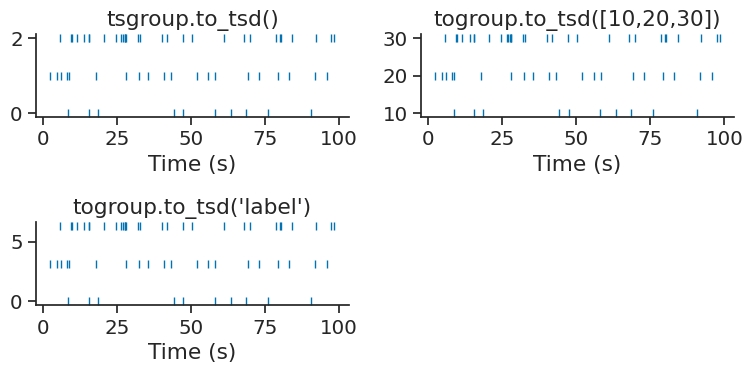
Special slicing: TsdFrame#
For users that are familiar with pandas, TsdFrame is the closest object to a DataFrame, but there are distinctive behavior when slicing the object. TsdFrame behaves primarily like a numpy array. This section lists all the possible ways of slicing TsdFrame.
1. If not column labels are passed#
tsdframe = nap.TsdFrame(t=np.arange(4), d=np.random.randn(4,3))
print(tsdframe)
Time (s) 0 1 2
---------- --------- ------- -----------
0 1.14012 1.35945 -0.0529354
1 0.120518 2.35429 0.67727
2 -0.551339 1.01876 -0.395928
3 0.734889 1.43614 0.00393599
dtype: float64, shape: (4, 3)
Slicing should be done like numpy array:
tsdframe[0]
array([ 1.14012238, 1.35945021, -0.05293539])
tsdframe[:, 1]
Time (s)
---------- -------
0 1.35945
1 2.35429
2 1.01876
3 1.43614
dtype: float64, shape: (4,)
tsdframe[:, [0, 2]]
Time (s) 0 2
---------- --------- -----------
0 1.14012 -0.0529354
1 0.120518 0.67727
2 -0.551339 -0.395928
3 0.734889 0.00393599
dtype: float64, shape: (4, 2)
2. If column labels are passed as integers#
The typical case is channel mapping. The order of the columns on disk are different from the order of the columns on the recording device it corresponds to.
tsdframe = nap.TsdFrame(t=np.arange(4), d=np.random.randn(4,4), columns = [3, 2, 0, 1])
print(tsdframe)
Time (s) 3 2 0 1
---------- --------- --------- --------- ----------
0 -1.56904 0.434513 1.18133 0.299281
1 -0.173723 0.549237 0.497252 0.734607
2 -0.288071 -1.19721 0.364564 -0.0124177
3 1.03578 1.59022 -1.25109 -0.457782
dtype: float64, shape: (4, 4)
In this case, indexing like numpy still has priority which can led to confusing behavior:
tsdframe[:, [0, 2]]
Time (s) 3 0
---------- --------- ---------
0 -1.56904 1.18133
1 -0.173723 0.497252
2 -0.288071 0.364564
3 1.03578 -1.25109
dtype: float64, shape: (4, 2)
Note how this corresponds to column labels 3 and 0.
To slice using column labels only, the TsdFrame object has the loc method similar to Pandas:
tsdframe.loc[[0, 2]]
Time (s) 0 2
---------- --------- ---------
0 1.18133 0.434513
1 0.497252 0.549237
2 0.364564 -1.19721
3 -1.25109 1.59022
dtype: float64, shape: (4, 2)
In this case, this corresponds to columns labelled 0 and 2.
3. If column labels are passed as strings#
Similar to Pandas, it is possible to label columns using strings.
tsdframe = nap.TsdFrame(t=np.arange(4), d=np.random.randn(4,3), columns = ["kiwi", "banana", "tomato"])
print(tsdframe)
Time (s) kiwi banana tomato
---------- --------- --------- ---------
0 0.160478 -1.42394 0.25443
1 1.14854 -1.06587 -1.33986
2 1.57913 -0.924523 -1.42492
3 -0.597792 -2.15974 0.515649
dtype: float64, shape: (4, 3)
When the column labels are all strings, it is possible to use either direct bracket indexing or using the loc method:
print(tsdframe['kiwi'])
print(tsdframe.loc['kiwi'])
Time (s)
---------- ---------
0 0.160478
1 1.14854
2 1.57913
3 -0.597792
dtype: float64, shape: (4,)
Time (s)
---------- ---------
0 0.160478
1 1.14854
2 1.57913
3 -0.597792
dtype: float64, shape: (4,)
4. If column labels are mixed type#
It is possible to mix types in column names.
tsdframe = nap.TsdFrame(t=np.arange(4), d=np.random.randn(4,3), columns = ["kiwi", 0, np.pi])
print(tsdframe)
Time (s) kiwi 0 3.141592653589793
---------- --------- --------- -------------------
0 0.395835 0.257652 0.950368
1 -0.327711 0.662865 1.11169
2 -0.546777 0.0769638 -0.49373
3 -0.34777 0.013601 -0.660781
dtype: float64, shape: (4, 3)
Direct bracket indexing only works if the column label is a string.
print(tsdframe['kiwi'])
Time (s)
---------- ---------
0 0.395835
1 -0.327711
2 -0.546777
3 -0.34777
dtype: float64, shape: (4,)
To slice with mixed types, it is best to use the loc method:
print(tsdframe.loc[['kiwi', np.pi]])
Time (s) kiwi 3.141592653589793
---------- --------- -------------------
0 0.395835 0.950368
1 -0.327711 1.11169
2 -0.546777 -0.49373
3 -0.34777 -0.660781
dtype: float64, shape: (4, 2)
In general, it is probably a bad idea to mix types when labelling columns.
Interval sets methods#
Interaction between epochs#
Intervals can be combined in different ways.
epoch1 = nap.IntervalSet(start=[0, 40], end=[10, 50]) # no time units passed. Default is us.
epoch2 = nap.IntervalSet(start=[5, 30], end=[20, 45])
print(epoch1, "\n")
print(epoch2, "\n")
index start end
0 0 10
1 40 50
shape: (2, 2), time unit: sec.
index start end
0 5 20
1 30 45
shape: (2, 2), time unit: sec.
union#
epoch = epoch1.union(epoch2)
print(epoch)
index start end
0 0 20
1 30 50
shape: (2, 2), time unit: sec.
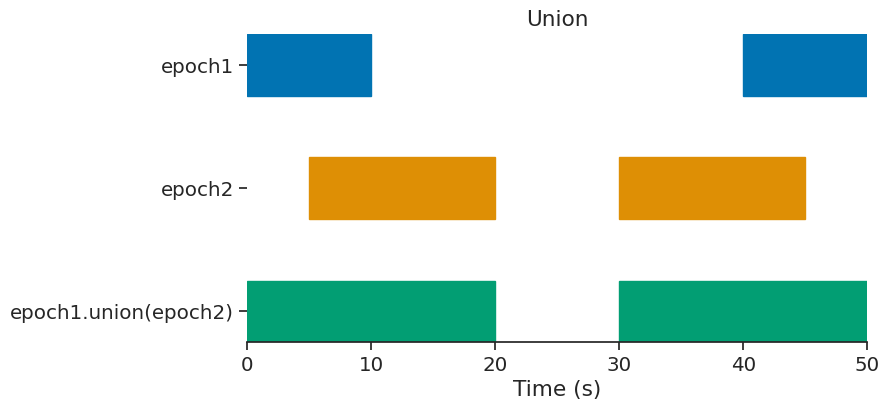
intersect#
epoch = epoch1.intersect(epoch2)
print(epoch)
index start end
0 5 10
1 40 45
shape: (2, 2), time unit: sec.
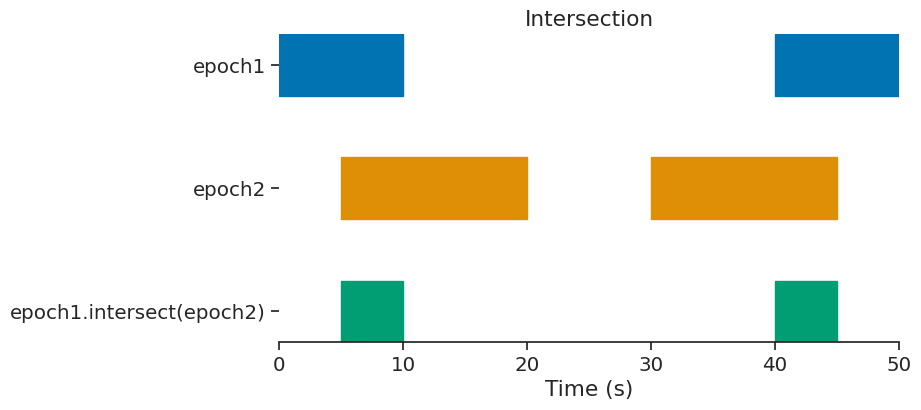
set_diff#
epoch = epoch1.set_diff(epoch2)
print(epoch)
index start end
0 0 5
1 45 50
shape: (2, 2), time unit: sec.
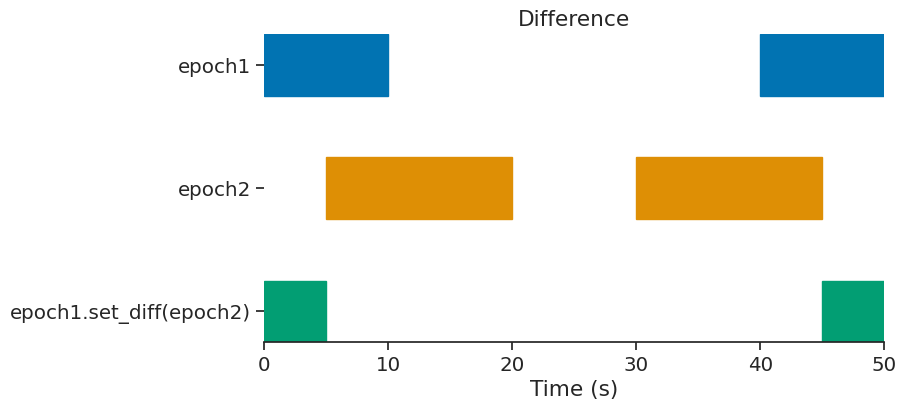
split#
Useful for chunking time series, the split method splits an IntervalSet in a new IntervalSet based on the interval_size argument.
epoch = nap.IntervalSet(start=0, end=100)
print(epoch.split(10, time_units="s"))
index start end
0 0 10
1 10 20
2 20 30
3 30 40
4 40 50
5 50 60
6 60 70
7 70 80
8 80 90
9 90 100
shape: (10, 2), time unit: sec.
Drop intervals#
epoch = nap.IntervalSet(start=[5, 30], end=[6, 45])
print(epoch)
index start end
0 5 6
1 30 45
shape: (2, 2), time unit: sec.
drop_short_intervals#
print(
epoch.drop_short_intervals(threshold=5)
)
index start end
0 30 45
shape: (1, 2), time unit: sec.
drop_long_intervals#
print(
epoch.drop_long_intervals(threshold=5)
)
index start end
0 5 6
shape: (1, 2), time unit: sec.
merge_close_intervals#
index start end
0 1 6
1 7 45
shape: (2, 2), time unit: sec.
If two intervals are closer than the threshold argument, they are merged.
print(
epoch.merge_close_intervals(threshold=2.0)
)
index start end
0 1 45
shape: (1, 2), time unit: sec.
